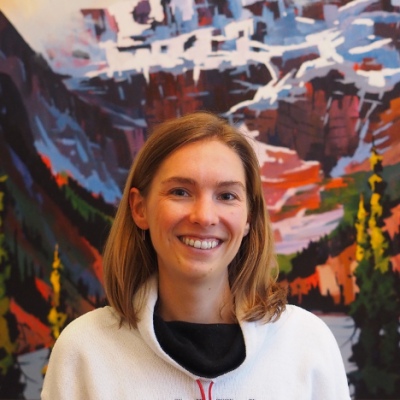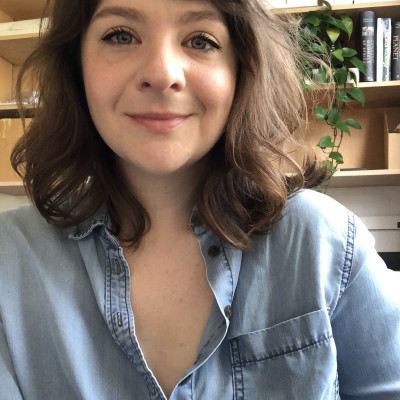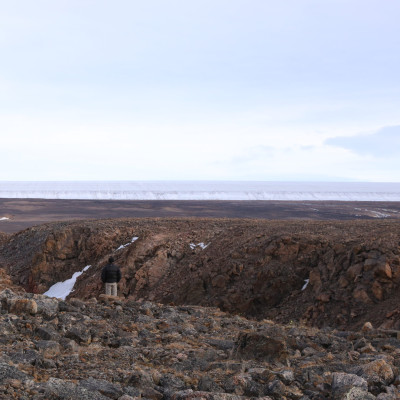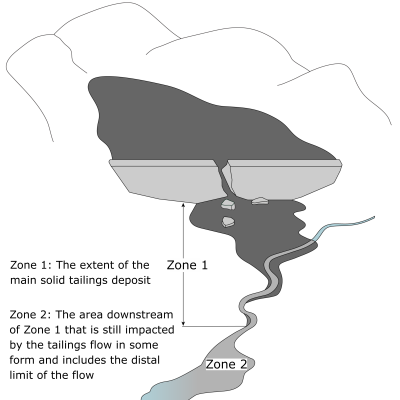News
Stay up-to-date with what's happening in EOAS
Happy Pride Month!
To Celebrate Pride Month, we’d like to draw your attention to some of our talented colleagues who identify as part of the LGBTQ2SIA+ Community. Hopefully their stories will help young queer people feel comfortable exploring a future in science. The Pacific Museum of Earth team designed this beautiful geo-Pride Flag using images of rocks and minerals in the museum's collection. Can you name all of the specimens that make up the flag? (answer key is at the bottom of this page)
Professor Kendra Chritz – Geochemist & Paleoecologist
Kendra Chritz is an assistant professor in the Department of Earth, Ocean & Atmospheric Sciences. She looks at the chemistry of ancient biological material (teeth, bones, soils) to tell what past environments were like. Her particular interest is in the intersecting interactions between people and their ecosystems over time: how the environments we evolved in made us who we are, how prone we are to modifying our environments, what we’re doing to environments now. Because of her particular focus on the ancient evolutionary aspect of her work, I do most of my research in museums around the world and in the field in eastern Africa, where we evolved.
Professor Sara Harris – Climate Science Educator
Sara Harris is a Professor of Teaching in the Department of Earth, Ocean and Atmospheric Sciences at the University of British Columbia. She typically teaches climate science, environmental science, and oceanography, which she will continue after she finishes serving in the Faculty of Science Dean's Office as Associate Dean Academic.
Anthony Di Stefano – Atmospheric Scientist
Anthony Di Stefano is a PhD student in the Department of Earth, Ocean & Atmospheric Sciences at the University of British Columbia. Anthony is an atmospheric scientist whose work aims to improve the representation of clouds and precipitation in weather forecast models. His goal is to produce higher-accuracy precipitation forecasts in British Columbia. In the new normal brought on by the COVID-19 pandemic, Anthony is taking time to re-examine his purpose, in research as in everyday life. His aim is to bring social and scientific views of the weather closer together, and to be part of a science community embracing greater standards of inclusion, equity and justice.
Daniel Gowryluk – Museum Educator
Daniel Gowryluk is the Education Outreach Coordinator and Assistant Curator at the Pacific Museum of Earth. Daniel joined the PME team in 2018 following a successful career path through several other science museums—from Manitoba to British Columbia. He has a passion for inspiring curiosity and wonder in all museum visitors and has fundamentally reshaped the museum’s outreach voice through his whimsical and upbeat personality.
Professor Mitch D’Arcy – Geomorphologist
Mitch D’Arcy is an Assistant Professor in the Department of Earth, Ocean & Atmospheric Sciences at the University of British Columbia. Mitch joined the faculty at UBC in March 2020, making him one of the newest faculty members. He is a geomorphologist who studies how climate change influences surface processes on Earth. Originally from London in the U.K., Mitch has been in Germany for the past years prior to his move to Vancouver.
Professor Stuart Sutherland – Micro-Palaeontologist
Stuart Sutherland is a micro-paleontologist and Professor of teaching in the Department of Earth, Ocean & Atmospheric Sciences at the University of British Columbia. Originally from the U.K., Stuart has been in Vancouver since 2000 when he joined the faculty at UBC. He is an award-winning educator and currently serves as the Chairperson of the Pacific Museum of Earth’s Governing Committee.
Geo-Pride Flag answer key:
Bars:
- Red = Zoisite/ Thulite from Canada
- Orange = Opalized wood from Nevada
- Yellow = Sulfur from San Felipe, Baja California, Mexico
- Green = Uvarovite from Russia
- Blue = Lapis from Afghanistan
- Purple = Amethyst from Brazil
Chevrons:
- Black = Hemtatite from Cumberland, UK
- Brown = Crocidolite from South Africa
- Pink = Rhodocrosite, No Location Data
- Blue = Halite/Salt from Saskatchewan
- White = Opal from Coober Pedy, South Australia
On Earth with Dr. Lindsey Heagy
Lindsey Heagy is joining EOAS as an Assistant Professor this July. She completed her BSc in geophysics at the University of Alberta in 2012 and her PhD at UBC in 2018, where she was a Vanier Scholar. Following the completion of her PhD, she was a Postdoctoral researcher in the Statistics Department at UC Berkeley. Her research interests are in data science and inverse theory, and she is interested in applications including minerals, groundwater, and environmental studies. She is a co-founder and project-lead for SimPEG, an open-source software project for geophysical inversions that has been adopted by geoscientists internationally at multiple universities, national labs, and mining companies. In 2019, she was awarded the Gerald W. Hohmann Outstanding Young Scientist award for advances in simulation and inversion of electromagnetic data and promotion of an open source culture for collaborative, inclusive and reproducible research.
On Earth with Dr. Kendra Chritz
Dr. Kendra Chritz looks at the chemistry of ancient biological material (teeth, bones, soils) to tell what past environments were like. Her particular interest is in the intersecting interactions between people and their ecosystems over time: how the environments we evolved in made us who we are, how prone we are to modifying our environments, what we’re doing to environments now. Because of her particular focus on the ancient evolutionary aspect of her work, I do most of my research in museums around the world and in the field in eastern Africa, where we evolved.
Early Mars was covered in ice sheets, not flowing rivers
Anna Grau Galofre, Mark Jellinek, and Gordon 'Oz' Osinski
A large number of the valley networks scarring Mars’s surface were carved by water melting beneath glacial ice, not by free-flowing rivers as previously thought, according to new UBC research published today in Nature Geoscience. The findings effectively throw cold water on the dominant “warm and wet ancient Mars” hypothesis, which postulates that rivers, rainfall and oceans once existed on the red planet.
To reach this conclusion, lead author Anna Grau Galofre, former PhD student in the Department of Earth, Ocean and Atmospheric Sciences, developed and used new techniques to examine thousands of Martian valleys. She and her co-authors also compared the Martian valleys to the subglacial channels in the Canadian Arctic Archipelago and uncovered striking similarities.
“For the last 40 years, since Mars’s valleys were first discovered, the assumption was that rivers once flowed on Mars, eroding and originating all of these valleys,” says Grau Galofre. “But there are hundreds of valleys on Mars, and they look very different from each other. If you look at Earth from a satellite you see a lot of valleys: some of them made by rivers, some made by glaciers, some made by other processes, and each type has a distinctive shape. Mars is similar, in that valleys look very different from each other, suggesting that many processes were at play to carve them.”
The similarity between many Martian valleys and the subglacial channels on Devon Island in the Canadian Arctic motivated the authors to conduct their comparative study. “Devon Island is one of the best analogues we have for Mars here on Earth—it is a cold, dry, polar desert, and the glaciation is largely cold-based,” says co-author Gordon Osinski, professor in Western University’s Department of Earth Sciences and Institute for Earth and Space Exploration.
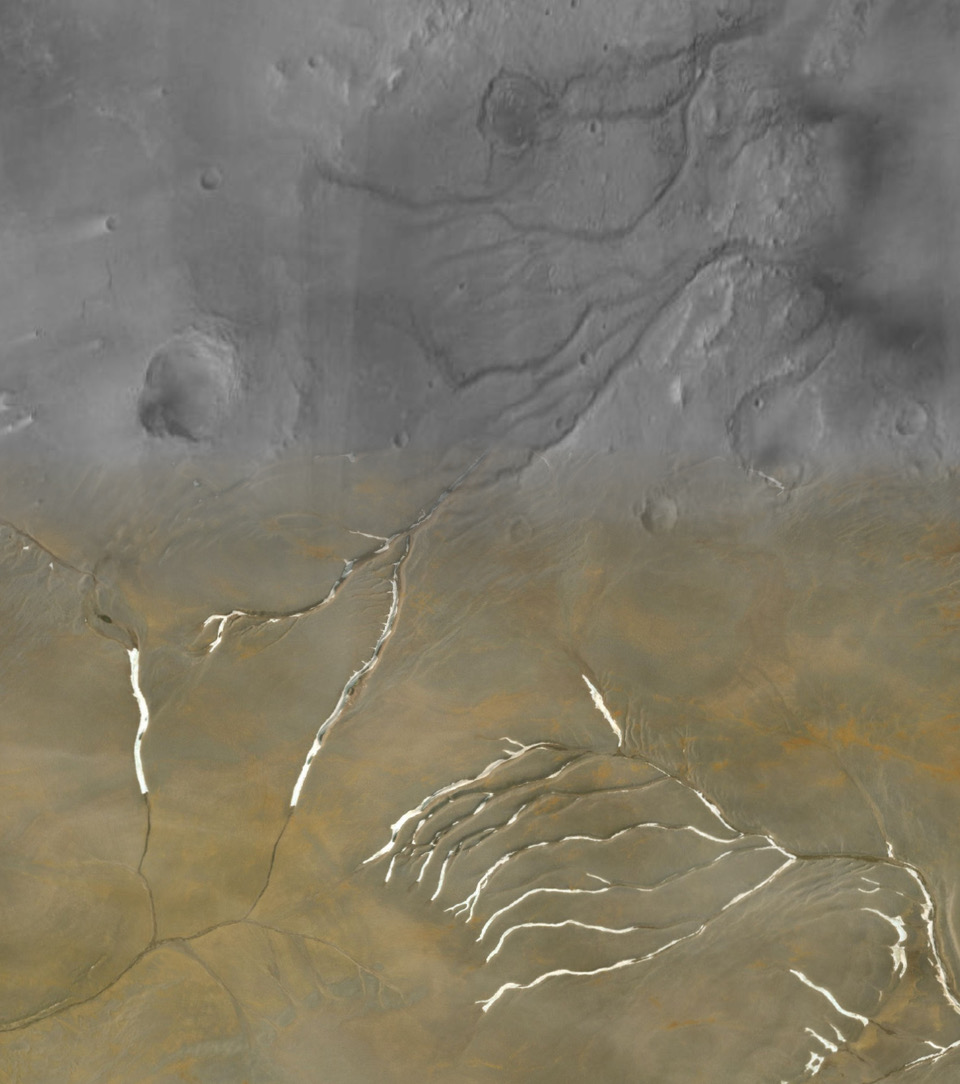
Collage showing Mars’s Maumee valleys (top half) superimposed with channels on Devon Island in Nunavut (bottom half). The shape of the channels, as well as the overall network, appears almost identical. Credit: Cal-Tech CTX mosaic and MAXAR/Esri.
In total, the researchers analyzed more than 10,000 Martian valleys, using a novel algorithm to infer their underlying erosion processes. “These results are the first evidence for extensive subglacial erosion driven by channelized meltwater drainage beneath an ancient ice sheet on Mars,” says co-author Mark Jellinek, professor in UBC’s department of earth, ocean and atmospheric sciences. “The findings demonstrate that only a fraction of valley networks match patterns typical of surface water erosion, which is in marked contrast to the conventional view. Using the geomorphology of Mars’ surface to rigorously reconstruct the character and evolution of the planet in a statistically meaningful way is, frankly, revolutionary.”
Grau Galofre’s theory also helps explain how the valleys would have formed 3.8 billion years ago on a planet that is further away from the sun than Earth, during a time when the sun was less intense. “Climate modelling predicts that Mars’ ancient climate was much cooler during the time of valley network formation,” says Grau Galofre, currently a SESE Exploration Post-doctoral Fellow at Arizona State University. “We tried to put everything together and bring up a hypothesis that hadn’t really been considered: that channels and valleys networks can form under ice sheets, as part of the drainage system that forms naturally under an ice sheet when there’s water accumulated at the base.”
These environments would also support better survival conditions for possible ancient life on Mars. A sheet of ice would lend more protection and stability of underlying water, as well as providing shelter from solar radiation in the absence of a magnetic field—something Mars once had, but which disappeared billions of years ago.
While Grau Galofre’s research was focused on Mars, the analytical tools she developed for this work can be applied to uncover more about the early history of our own planet. Jellinek says he intends to use these new algorithms to analyze and explore erosion features left over from very early Earth history.
“Currently we can reconstruct rigorously the history of global glaciation on Earth going back about a million to five million years,” says Jellinek. “Anna’s work will enable us to explore the advance and retreat of ice sheets back to at least 35 million years ago—to the beginnings of Antarctica, or earlier—back in time well before the age of our oldest ice cores. These are very elegant analytical tools.”
Empirical mass flow runout analysis: Innovative new tools
Negar Ghahramani, Andrew Mitchell, and Scott McDougall
Mass flows of geological materials can travel substantial distances, causing significant loss of life, environmental damage, and economic costs. The Geohazards Research Team within the Geological Engineering program studies a variety of these phenomena, including natural events like rock avalanches and debris flows, and human-related events such as flows resulting from tailings dam breaches. The hazards from these events are largely related to their mobility, how far they travel and how much they spread, which can be quite uncertain. Case studies of real events are key to developing better empirical methods, either based on physical scaling laws, statistical relationships, or a combination of both, to estimate the extent of potential flows. The first stage of both of these pieces of work was to develop consistent definitions and criteria for describing and mapping the case studies. Empirical relationships for both tailings flows and rock avalanches were developed using the new databases which can be used both in academia for future studies and in industry for practical application to risk management problems. This work show the potential for applying similar methods to a wide variety of flow-like processes.
“Viruses and nutrient cycles in the sea” is honored with the John H. Martin Award by ASLO
“Viruses and nutrient cycles in the sea”, 1999, by Drs. Steven Wilhelm (University of Tennessee) and Curtis Suttle (University of British Columbia) recently received the 2021 John H. Martin Award presented by the Association for the Sciences of Limnology and Oceanography (ASLO). This award is given to one paper each year that has led to fundamental shifts in research focus and interpretation of a large body of previous observations. The award will be presented at the 2021 ASLO Aquatic Sciences Virtual Meeting in June.
The foundational 1999 paper, conceived while Wilhelm was a postdoctoral associate in the Suttle lab, originated the concept of the ‘viral shunt,’ the phenomenon in which viral infection of marine microbes redirects organic carbon flow away from higher tropic levels and through the microbial loop. Drawing on early estimates of viral production in the water column, Wilhelm and Suttle shined a light on the considerable role viruses play in ocean biogeochemical cycles at a time when much of the research was focused on describing viral diversity and distribution. Their calculations showed that a staggering 25% of all photosynthetically fixed carbon, and associated nutrients, in the ocean may be recycled through the viral shunt. Additionally, Wilhelm and Suttle made some of the first estimates of the total carbon stored in the viral pool and made eye-opening comparisons to the carbon stored in other types of marine organisms (including whales). Today, the concept of the viral shunt continues to influence our understanding of ocean ecosystem functioning and nutrient cycles. With >1000 citations, and more than 300 in the last five years, the legacy of “Viruses and nutrient cycles in the sea” and the viral shunt concept is still strongly felt in the field today.
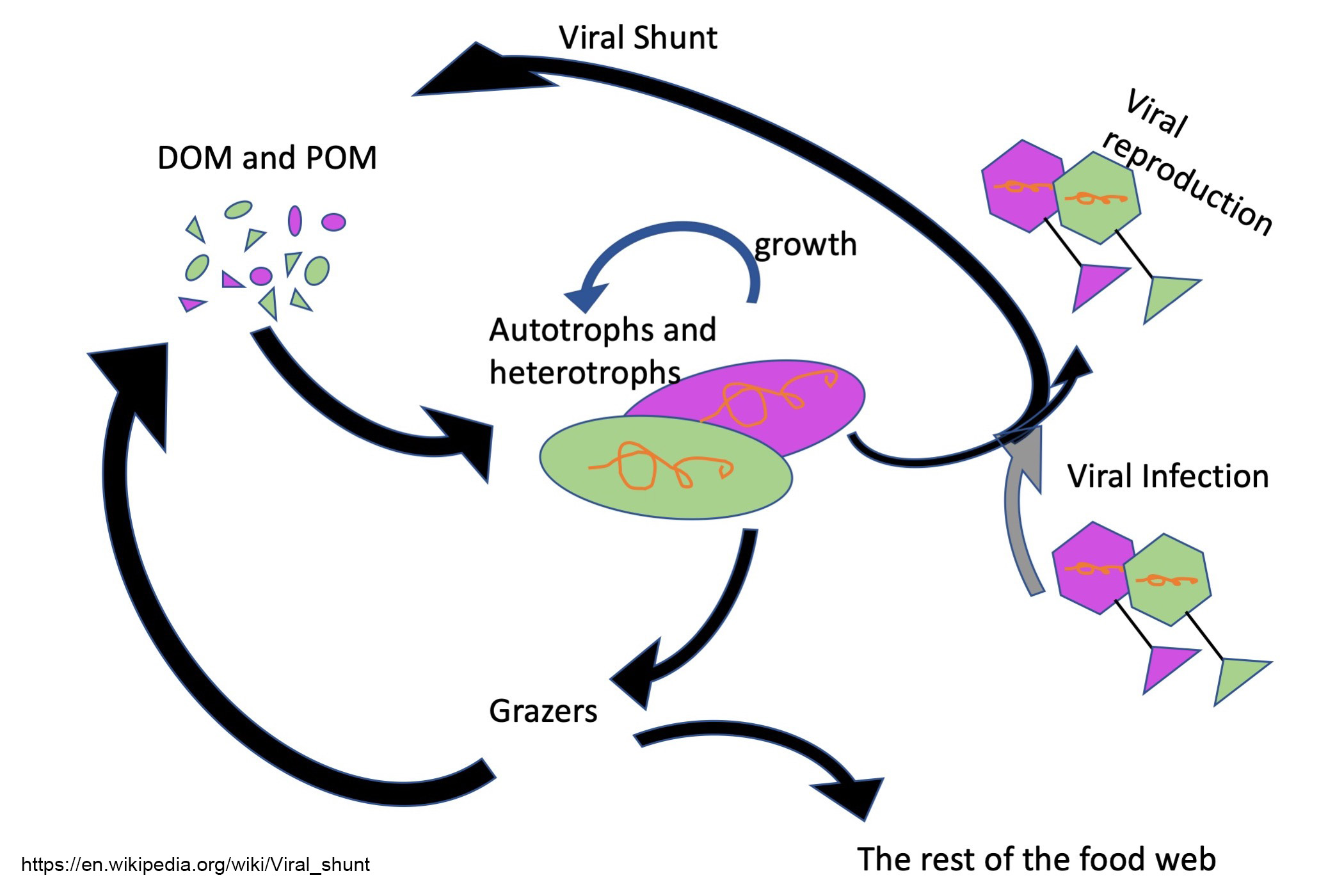 “Every so often a novel concept is described which truly transforms a scientific field for decades,” says ASLO President Roxane Maranger. “Wilhelm and Suttle’s concept of the ‘viral shunt’ as a major pathway of oceanic carbon flow in their 1999 paper is a stunning example of such a transformation.”
“Every so often a novel concept is described which truly transforms a scientific field for decades,” says ASLO President Roxane Maranger. “Wilhelm and Suttle’s concept of the ‘viral shunt’ as a major pathway of oceanic carbon flow in their 1999 paper is a stunning example of such a transformation.”
Full Citation: Wilhelm, S.W. and C.A. Suttle. 1999. Viruses and nutrient cycles in the sea, BioScience 49(10): 781-788. doi.org/10.2307/1313569.

